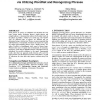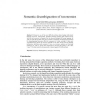184 search results - page 16 / 37 » Learning Expressive Models for Word Sense Disambiguation |
ACL
2003
13 years 9 months ago
2003
We present a supervised machine learning algorithm for metonymy resolution, which exploits the similarity between examples of conventional metonymy. We show that syntactic head-mo...
FLAIRS
2008
13 years 10 months ago
2008
The problem of recognizing textual entailment (RTE) has been recently addressed using syntactic and lexical models with some success. Here, we further explore this problem, this t...
SIGIR
2004
ACM
14 years 1 months ago
2004
ACM
Noun phrases in queries are identified and classified into four types: proper names, dictionary phrases, simple phrases and complex phrases. A document has a phrase if all content...
WWW
2008
ACM
14 years 8 months ago
2008
ACM
In a higher level task such as clustering of web results or word sense disambiguation, knowledge of all possible distinct concepts in which an ambiguous word can be expressed woul...
CCIA
2007
Springer
14 years 1 months ago
2007
Springer
Polysemy is one of the most difficult problems when dealing with natural language resources. Consequently, automated ontology learning from textual sources (such as web resources) ...


